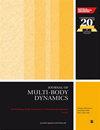六分支人字齿轮传动系统负载共享特性研究
IF 1.9
4区 工程技术
Q3 ENGINEERING, MECHANICAL
Proceedings of the Institution of Mechanical Engineers Part K-Journal of Multi-Body Dynamics
Pub Date : 2023-11-09
DOI:10.1177/14644193231211233
引用次数: 0
摘要
随着高速、大功率齿轮传动技术的不断发展,以及航空、航海等领域对高速、重型齿轮传动系统减振降噪的新需求,对人字齿轮分支传动系统的动态特性提出了更高的要求。因此,有必要对大功率大扭矩人字齿轮分支传动系统的动态特性进行研究。基于集总参数法,建立了传动系统弯扭耦合动力学模型,提出了一种载荷分担系数的计算方法。得到了在时变内激励作用下传动系统同一啮合周期内各齿轮副的LSCs。在ADAMS中计算了六支齿轮传动系统的啮合力,验证了所建立动力学模型的有效性。研究结果表明,误差对共享性能有负向影响。为了保持共享系数低于1.15,齿轮z5和齿轮z6的制造和安装误差应分别限制在9µm和7µm。在支承刚度方面应特别注意齿轮z5,其值为1 × 10 8 N/m是最有利的。在系统设计时,应考虑初始阶段的安装误差,最好选择在180°附近。此外,该系统具有较高的输入功率,更容易分担负载。双轴的最优扭转刚度为5 × 10 7 N/m,最优弯曲刚度为5 × 10 8 N/m。本研究旨在为船用大功率齿轮传动系统的设计与优化提供理论依据。本文章由计算机程序翻译,如有差异,请以英文原文为准。
Research on load-sharing characteristics of six-branch herringbone gear transmission system
With the continuous development of high-speed and high-power gear transmission technology, as well as the new demand for vibration and noise reduction in high-speed and heavy-duty gear transmission systems in fields such as aviation and navigation, the herringbone gear branch transmission system is subject to higher requirements in terms of its dynamic characteristics. Therefore, it is necessary to conduct research on the dynamic characteristics of high-power and high-torque herringbone gear branch transmission systems. Based on the lumped parameter method, a bending-torsion coupling dynamic model of the transmission system is established, and a calculation method for load-sharing coefficients (LSCs) is proposed. The LSCs are obtained for each gear pair in the same meshing period of the transmission system that is under the interaction of time-varying internal excitation. The meshing force of the six-branch gearing system was calculated in ADAMS to verify the validity of the established dynamic model. The study results indicate that errors have a negative impact on the sharing performance. To maintain a sharing coefficient below 1.15, the manufacturing and installation errors of gears Z 5 and Z 6 should be restricted to 9 µm and 7 µm, respectively. Special attention should be given to gear Z 5 in terms of support stiffness, with a value of 1 × 10 8 N/m being the most favorable. During the system design, the initial phase of the installation error should be considered and preferably selected near 180°. Additionally, the system exhibits easier load sharing with higher input power. The optimal torsional stiffness of the duplex shaft is 5 × 10 7 N/m, while the optimal bending stiffness is 5 × 10 8 N/m. This study aimed to provide a theoretical foundation for the design and optimization of marine high-power gear transmission systems.
求助全文
通过发布文献求助,成功后即可免费获取论文全文。
去求助
来源期刊

CiteScore
4.10
自引率
11.10%
发文量
38
审稿时长
>12 weeks
期刊介绍:
The Journal of Multi-body Dynamics is a multi-disciplinary forum covering all aspects of mechanical design and dynamic analysis of multi-body systems. It is essential reading for academic and industrial research and development departments active in the mechanical design, monitoring and dynamic analysis of multi-body systems.
 求助内容:
求助内容: 应助结果提醒方式:
应助结果提醒方式:


